 |
This task shows how to join at least two surfaces or
two curves. The surfaces or curves to be joined must be
adjacent. |
 |
Open the Join1.CATPart
document. |

|
-
Click the Join  icon.
icon.
The Join Definition dialog box appears.
|
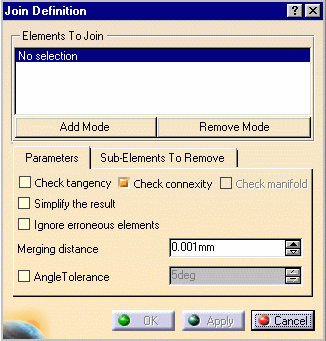 |
|
-
Select the surfaces or curves to be
joined.
-
You can edit the list of elements
to be joined:
|
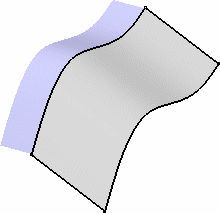 |
|
 | by selecting elements in the geometry:
 | Standard selection (no button clicked):
when you click an unlisted element, it is added to the list
when you click a listed element, it is removed from the list |
 | Add Mode:
when you click an unlisted element, it is added to the list
when you click a listed element, it remains in the list |
 | Remove Mode:
when you click an unlisted element, the list is unchanged
when you click a listed element, it removed from the list |
|
 | by selecting an element in the list then using the Remove\Replace
contextual menu items. |
|
 |
If you double-click the Add Mode
or Remove Mode button, the chosen mode is permanent, i.e. successively selecting elements will add/remove them. However if
you click only once, only the next selected element is added or removed.
You only have to click the button
again, or click another one, to deactivate the mode. |
|
-
Right-click the elements from the list and choose the Check
Solution command.
This let's you check whether any element to be joined
presents any intersection (i.e. at least one common point) with other
elements prior to creating the joined surface:
|
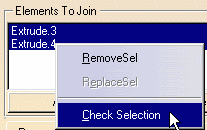 |
|
The Checker dialog box is displayed, containing the list of domains
(i.e. sets of connected cells) belonging to the selected elements
from the Elements To Join list.
-
Click Apply.
|
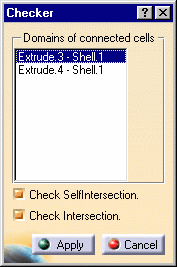 |
 |
 | An Information message is issued when no intersection is
found. |
|
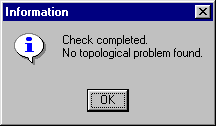 |
|
 | When an element is self-intersecting, or when several
elements intersect, a text is displayed on the geometry, where the
intersection is detected. |
|
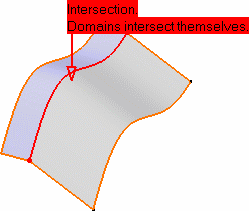 |
|
-
Click Cancel to return to the Join Definition dialog
box.
|
 |
-
Right-click the elements from the list and choose the
Propagate command. It allows the selection of elements of
same dimension to be added to the Elements To Join
list.
|
 |
 | The initial element to propagate cannot be a sub-element |
 | Forks stop the propagation |
 | Intersections are not detected |
|
|
-
Click Apply in the Join Definition dialog box.
The joined element is previewed, and its orientation
displayed. Click the arrow to invert it if needed.
|
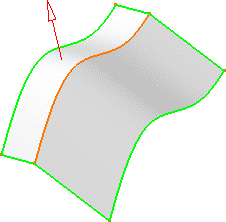 |
 |
The join is oriented according to the first
element in the list. If you change this element, the join's orientation is
automatically set to match the orientation of the new topmost element in
the list. |
 |
-
Check the Check tangency button to find out whether the elements to be joined are
tangent. If they are not, and
the button is checked, an error message is issued.
|
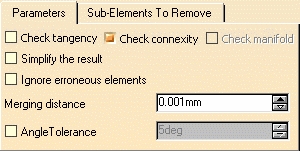
|
|
-
Check the Check connexity button to find out whether the elements to be joined are
connex. If they are not, and
the button is checked, an error message is issued indicating the number of
connex domains in the resulting join.
When clicking Apply, the free boundaries are highlighted, and help you
detect where the joined element is not connex.
|
 |
-
Check the Check
manifold button to find out whether the resulting join is
manifold.
|
 |
The Check manifold button
is only available with curves.
Checking it automatically checks the Check connexity button. |
|
The Simplify the result check button allows the system to
automatically reduce the number of elements (faces or edges) in the resulting join whenever
possible.
|
|
The Ignore erroneous elements check button lets the
system ignore elements that would not allow the join to be created.
|
|
-
You can also set the tolerance at which two elements are considered
as being only one using the Merging distance.
|
|
-
Check the Angle Tolerance button to specify
the angle value below which the elements are to be joined.
If the angle value on the edge between two elements is greater than
the Angle Tolerance value, the elements are not joined.
This is particularly useful to avoid joining overlapping elements.
|
 |
If
the edges or the faces have a angular threshold higher than the predefined
value, a text is displayed on the geometry indicating the error type.
You can either deactivate the check box or increase the value of the
angular threshold, or remove all the elements or sub-elements that are in
error. |
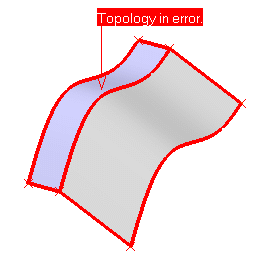 |
|
-
Click the Sub-Elements To Remove
tab to display the list of sub-elements in the join.
These sub-elements are elements making up the elements
selected to create the join, such as separate faces of a surface for
example, that are to be removed from the join currently being created.
You can edit the sub-elements list as described above for the list
of elements to be joined.
|
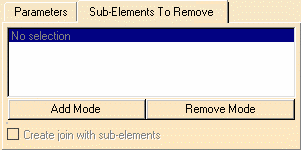
|
|
-
Check the Create join with sub-elements option to
create a second join, made of all the sub-elements displayed in the
list, i.e. those that are not to be joined in the first join.
This option is active only when creating the first join, not when
editing it.
|
|
-
Click OK to
create the joined surface or curve.
The surface or curve
(identified as Join.xxx) is added to the specification tree.
|
 |
 | Sometimes elements are so close that it is not easy to see
if they present a gap or not, even though they are joined.
Check the Surfaces' boundaries option from the Tools -> Options menu
item, General, Display, Visualization tab. |
|
|
 | Once the Join.xxx element has been created, you can use the Check
contextual menu from the specification tree. In this case
however it verifies the connexity of all the sub-elements making up the
joined surface. This is particularly useful when many elements
have been joined, so has to highlight in the geometry which
sub-element is not connected to the other ones, thus allowing you to
rework the geometry if needed. |
|
|

|









